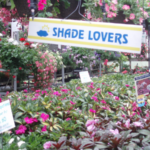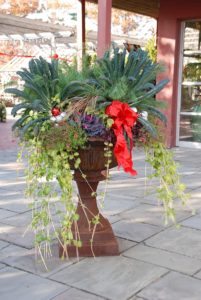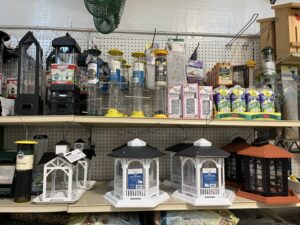Color Squared
Color! Everyone knows color sells. If there was ever an overused statement in recent years, this would be in the top five. Yet, how many of you are truly taking advantage of the opportunities before you when it comes to using color to sell product in your stores?
For many garden centers, a bench full of flowers or foliage is how color is defined and correctly so. After all, this type of display most accurately simulates consumers’ visions of what they want their gardens to look like and it provides inspiration.
Typical of this kind of display is it contains no more than three of any one plant because of space limitations, and it only takes one shopper buying a few plants off the display to reduce it to a cluttered mess. It is this very chaos that overwhelms consumers’ senses and leads them to leave with their money still in their purses.
How can you reverse this process while relieving your staff of a restocking nightmare and dramatically increasing your sales? Let’s look at two principles; the first is the use of only two colors in any display, a primary color and a secondary complementing or contrasting color, secondly, the use of large blocks of color to create impact.
Getting Started
How do you know what to put with what? After all, you, like most people, may be color challenged. The easiest way to answer that question may be to buy a color wheel. The problem is you can never find the color wheel when you need it, can you? An even easier method is simply to look at the plants and flowers that are in your display and duplicate what is created so beautifully in your gardens.
For example, take a rose like ‘John Franklin’. If you look at the colors found in this bloom, you have the keys to creating a stunning display. A large block of these roses would sell on impulse alone, but what would happen if you added a plant that echoes the bright, golden-yellow stamens found in ‘John Franklin’ via either flowers or foliage? The effect would be “Wow!” And customers will respond to a wow every time.
Let’s take the color purple and look at what happens if you create displays by adding just one color. In the case of aster ‘Purple Dome’, let’s again start with an echo of the stamen color. The plant chosen is solidago ‘Golden Fleece’ and the display is found in the landscape. As you can see in the photo, page 28, the impact is immediate and it raises the question, “What is your best-selling purple perennial?” Could it possibly be a salvia? If so, the next question is, “What plant are you displaying with it?” How about pairing coreopsis ‘Moonbeam’ or ‘Autumn Blush’ with the salvia on a display or an endcap. Better yet, put some salvia ‘May Night’ on the bench with the red geraniums now that would be an eye-catching display. Just make sure you are ready with more.
With yellows and golds, you might try pairing burgundy tones with them. A perfect example is phormium ‘Pink Stripe’ paired with caryopteris ‘Sunshine Blue’ or a coleus. What about weigela ‘Wine & Roses’, a plant many of us sell, paired with black-eyed Susans or Stella d’ Oro? In both examples, we are mixing shrubs with tropicals or perennials, but does your customer really care? Remember, she is coming to your store looking for ideas, and odds are those annuals she has in her cart are going into the landscape possibly along the sidewalk right next to the perennials and shrubs. How stunning would a display look with a block of spiraea ‘Goldmound’ paired with Japanese maples? See for yourself in the photo on page 26.
The Power Of More?
Another way to create wow in your stores is by having large masses of color. This is something everyone does just take a look at your benches of red geraniums. How many geraniums do you sell? A lot? Is it because geraniums are so popular or because such a large mass of color is so irresistible? Both answers are probably true, and yet, it is like the chicken and the egg: Which came first? Did you buy your first geraniums because the rich, red color pulled you over to the bench? That is why I bought them the first time. I wanted that same wow statement in my yard. Little did I know at the time that getting the geranium to perform and look just as nice in my yard as it did in the garden center requires more than just planting.
If large blocks of color are so effective for selling annuals, why not apply the same thought process to selling other things like perennials, roses or even shrubs? Take a look at the perennials you sell. What are your top 10 sellers for the season?
What would happen if you applied the same thought process to a foliage plant like hosta? Let’s take a closer look at hosta ‘Patriot’ since it is an easy-selling hosta. Traditionally, hosta ‘Patriot’ is found on the hosta table in groups of 10-15 with the rest of the hosta family. Yet, among all these wonderful hostas, it is ‘Patriot’s’ foliage color that makes it very impulsive. How would you display it using the principles of mass and a complementary color?
What would happen if you displayed it on its own endcap at the end of the hosta bench and, instead of having 10-15 plants on display, you had 25-30? Better yet, create an island display, and then the question is what could you pair it with. A block of ferns might be a good place to start since both can handle shade.
How about using your PJM rhododendrons when they are in flower? What would happen if you placed a block of 20-25 on the bench with your begonias ‘Dragon Wing’ or red impatiens? Pair the red flowers with the pure white varie-gation of hosta ‘Patriot’ and wow!
The Power Of Less
Having talked about how important it is to have “more,” as in big masses of color, it is only fitting to discuss “less” with respect to building your displays. Again, consider the basic differences between the bench of geraniums and the bench of hostas. On one you have 10-12 plants of 25+ varieties and on the other 25 flats or 8-inch pots of less than 10 colors. Take a minute and step back 20-30 ft. from each bench to see which has more impulse appeal. The geraniums?
This brings us to a very important point: When putting together a display, less is more as in less choices. Fifty plants of one variety on an octagon display table will sell through much quicker than 10 plants of five varieties. Given too many choices, your customer is as likely to leave her money in her pocket as to pick a plant up. Can you use two varieties or colors on a display? Absolutely! How about more than that? Consider starting with just two colors so you can really understand the power and impact this principle can have on your business. Then if you want to do more, make the third element something that creates theater (more on theater another time).
Secondly, the reason why it is important to start with more plants in only 1-2 colors comes from understanding what happens to that display after the customer shops it. If you only use 10-12 plants of just 4-5 varieties, how long will that display look stunning? Not long, probably for the length of time it takes you to walk away and for a couple customers to come and put some plants in their carts. Ten plants turns into 67 plants very quickly and now you are left with too few for impact, not to mention frustrated employees who cannot keep up with restocking the displays let alone helping customers and watering plants. If your employees are smiling, your customers will be too.
What Next?
Where do you begin? Let’s start with a couple of questions.
How many displays and endcaps do you have? Start out with a limited number of color hot spots (displays) and concentrate on having enough quantity of the key items that you can keep the display filled for a week. If you run out, that means great things are happening and you simply switch out the display.
What are your top sellers in each category? Annuals? Perennials? Shrubs? Start with a limited number of items, again remembering it has to be manageable for both you and your staff. From the list of plants, you can determine what will be displayed during what week and/or month, and this can be put onto a “merchandising calendar.”
One way to pick up some ideas on what is really eye catching is to simply take a minute early in the morning and walk through your garden center. What grabs your attention? Write it down or, better yet, have those items moved to an endcap or island display.
Look to cross merchandise a “hot seller” in multiple locations and resist the temptation to use more than one complement with any one of your hot sellers. This will maximize the impulse appeal and increase your move through. The goal of creating wow is best met with large masses of color, and too many options only serve to dilute the impulse of a single color.


















 Videos
Videos





